

“Portraits of the Passion:
Trial, Condemnation, and Flagellation”
John 18:28-19:16
Pastor Kevin Vogts
Trinity Lutheran Church
Paola, Kansas
Lent Service II—March 4, 2020
Grace to you and peace from God our Father and the Lord
Jesus Christ. Amen.
Our Lenten sermon series this year is “Portraits of the Passion,” the
Lenten story illustrated with slides of artworks from the Nelson-Atkins Museum
and Spencer Museum of Art at the University of Kansas. We continue this
evening with Christ’s “Trial, Condemnation, and Flagellation.”
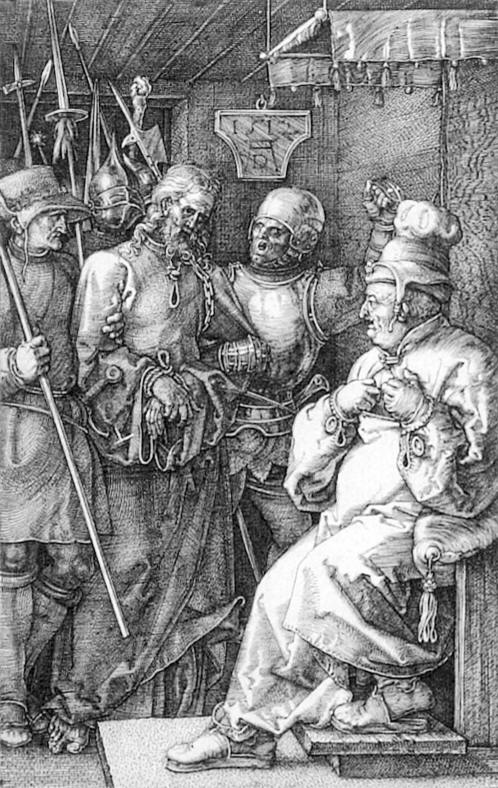
“Christ Before Caiaphas”
Albrecht Dürer – 1512 – Woodcut – Nelson-Atkins Museum
After his arrest in the Garden of Gethsemane, Jesus first appeared
before the high priests and their ruling council, the Sanhedrin. This
woodcut by the famous Lutheran artist Albrecht Durer dates from 1512 and is in
the collection of the Nelson-Atkins museum. It depicts Christ on trial
before Caiaphas the high priest. These Jewish authorities condemned Jesus to
death for blasphemy, but they were unable to carry out the sentence because the
Romans who occupied their country had recently reserved the right of execution
for themselves. And so they had to somehow convince the Roman governor
Pontius Pilate to carry out the execution of Jesus for them.
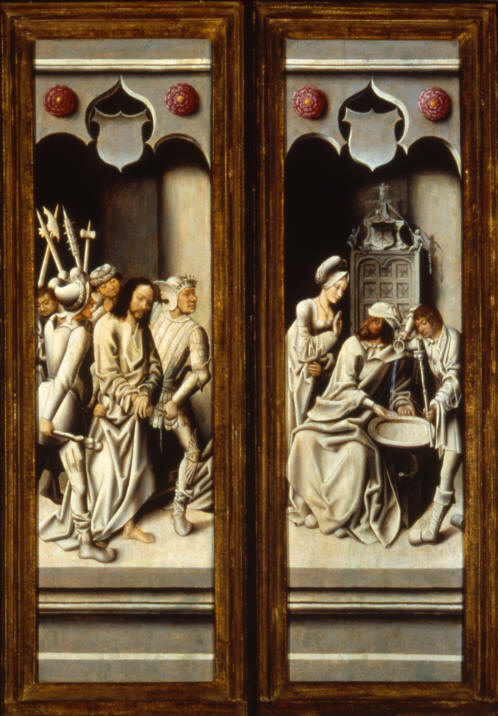
“Scenes of the Passion”
Workshop of the Master of Frankfurt – 1500’s – Oil on Oak Panels
These two German paintings from the 1500’s are part of a set of five
panels which were an altarpiece for above an altar. We will look at the
other three panels in our last sermon in this series. These two panels
depict: Christ being brought before Pilate; and the moment Pilate passes
judgment upon him.
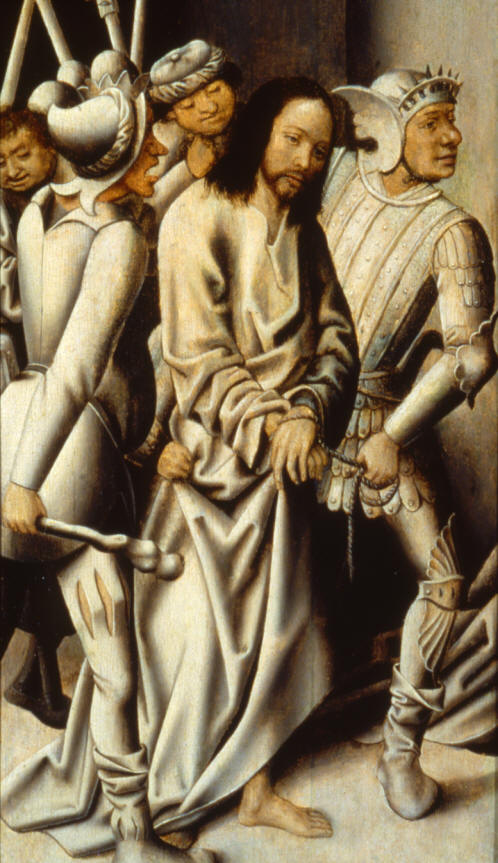
Detail from
“Scenes of the Passion”
Workshop of the Master of Frankfurt – 1500’s – Oil on Oak Panels
The first panel depicts Christ being brought before Pilate: “Early in
the morning, all the chief priests and the elders of the people came to the
decision to put Jesus to death. They bound him, led him away and handed
him over to Pontius Pilate, the governor.”
As was common in medieval and renaissance art, the soldiers are
whimsically portrayed in clothing appropriate to the period of the painting
rather than the time of the Bible.
But that club the soldier brandishes is not whimsical at all. In
the Garden of Gethsemane Jesus asked: “Am I leading a rebellion, that you have
come out with swords and clubs to capture me?” Already at the high
priest’s palace Jesus was savagely abused: “Then some began to spit at him; they
blindfolded him, struck him with their fists, and said, ‘Prophesy!’ And the
guards took him and beat him.” And at Pontius Pilate’s palace the abuse
was even more savage: “They struck him on the head with a stick again and again
and spit on him.”
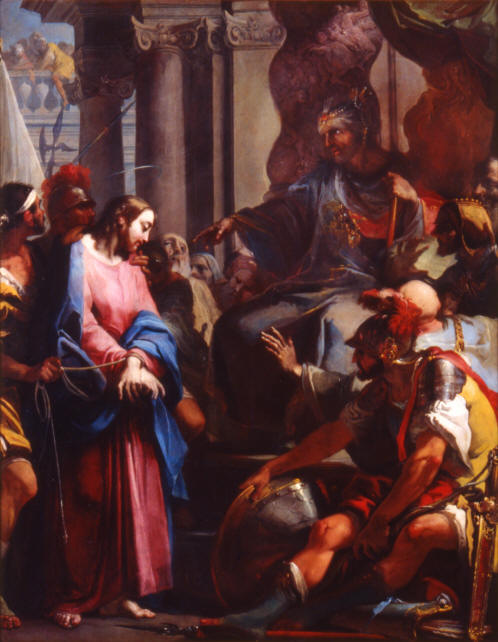
“Christ Before Pilate”
Giovanni Battista Crosato – c. 1720-1730 – Oil on Canvas
This Italian painting from the 1700’s also shows Christ before Pontius
Pilate. The Roman governor actually did not want to crucify Jesus.
Time after time, Pilate himself declares Jesus innocent. After
interrogating him, “Pilate announced to the chief priests and the crowd, ‘I find
no basis for a charge against this man.’” Pilate then sent Jesus to be
interrogated by Herod Antipas, and after Herod sent him back Pilate declared, “I
have examined him in your presence and have found no basis for your charges
against him. Neither has Herod, for he sent him back to us; as you can
see, he has done nothing to deserve death.” The centurion in charge of the
crucifixion proclaimed, “Surely this was a righteous man.” And the thief
on the cross beside Jesus testified, “This man has done nothing wrong.”
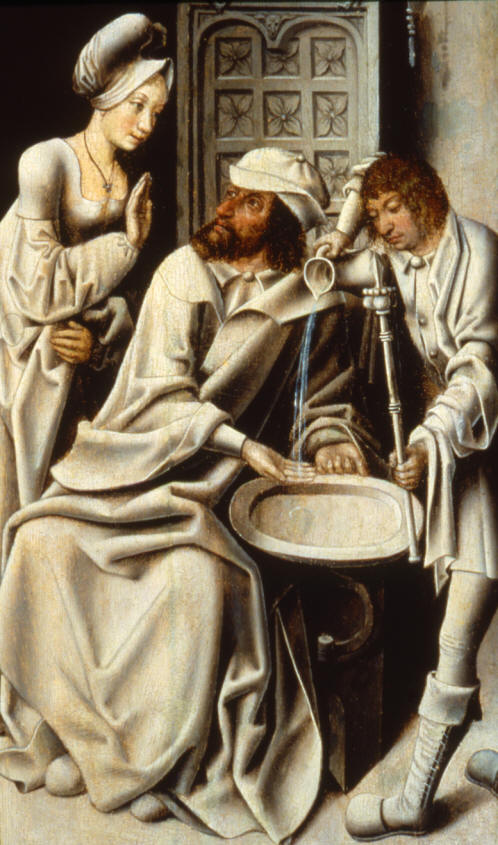
Detail from
“Scenes of the Passion”
Workshop of the Master of Frankfurt – 1500’s – Oil on Oak Panels
This panel of the altarpiece shows another interesting incident
attesting to Jesus’ innocence, recorded by Matthew:
“While Pilate was sitting on the judge’s seat, his wife sent him this
message: ‘Don’t have anything to do with that innocent man, for I have suffered
a great deal today in a dream because of him.”
This incident seems fanciful to modern readers—why would a powerful
Roman governor care about his wife’s dream? But, the dream of Pilate’s
wife is actually a fascinating, historically accurate detail. Believe it
or not, this dream of his wife was probably the one thing that worried Pontius
Pilate the most that day, and the main reason he tried in vain to set Jesus
free. Because, the night before Julius Caesar had been assassinated, his
wife had a dream that he should not go to the forum the next day. Ever
since, Roman politicians had taken their wives’ dreams very seriously.
Pontius Pilate, Herod Antipas, the centurion, the thief on the cross,
even Pilate’s wife—they all declare Jesus innocent. According to every
tenant of Roman law Jesus should have gone free, and the Gospels tell us Pilate
wanted to release Jesus and tried to set him free.
So why did a Roman governor give in to an angry mob’s bloodthirsty
demand for crucifixion? John reports, “Pilate tried to set Jesus free, but
the Jews kept shouting, ‘If you let this man go, you are no friend of Caesar.
Anyone who claims to be a king opposes Caesar.’ When Pilate heard this, he
brought Jesus out and sat down on the judge’s seat.”
Pilate gave in to their demand because they accused Jesus of treason
against the Empire, and Pilate of complicity with Jesus if he did not execute
him. Accusations of treason was also something Roman politicians took very
seriously, and this was a genuine threat against Pilate that could easily have
cost him his job or even his life. And so to save his own skin Pilate
condemns an innocent man.
This panel also depicts another incident recorded in Matthew, Pilate’s
pathetic attempt to absolve himself of guilt: “‘What shall I do, then, with
Jesus who is called Christ?’ Pilate asked. They all answered, ‘Crucify him!’
‘Why? What crime has he committed?’ asked Pilate. But they shouted all the
louder, ‘Crucify him!’ When Pilate saw that he was getting nowhere, but
that instead a riot was starting, he took water and washed his hands in front of
the crowd. ‘I am innocent of this man’s blood.’”
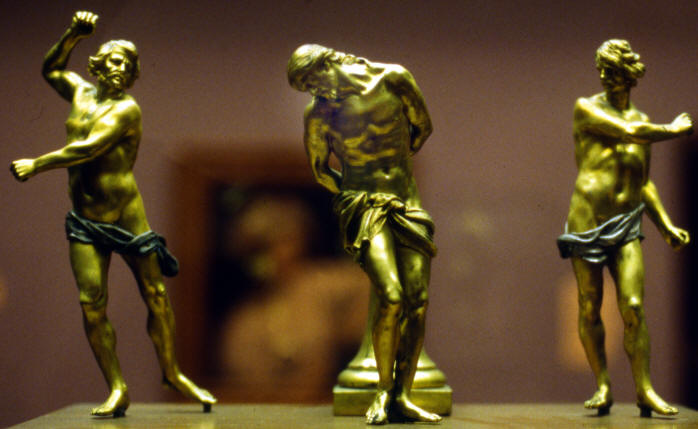
“Flagellation of Christ”
Allesandro Algardi and Francesco Du Quesnoy – 1600’s – Gilt Bronze
Following his condemnation by Pilate, Christ was subjected to one last
round of torture. The Roman practice of flagellation is graphically
portrayed in these Italian and French gilded bronze sculptures from the 1600’s
on display at the Spencer Museum, with two soldiers on each side and the wounded
Christ in the center. These sculptures are about 12 inches tall.
Originally there would have been whips in the soldiers’ hands.
“Pilate . . . had Jesus flogged, and handed him over to be crucified.
The soldiers led Jesus away into the palace . . . and called together the whole
company of soldiers. They put a purple robe on him, then twisted together
a crown of thorns and set it on him. And they began to call out to him,
‘Hail, king of the Jews!’ Again and again they struck him on the head with
a staff and spit on him. Falling on their knees, they paid homage to him.
And when they had mocked him, they took off the purple robe and put his own
clothes on him. Then they led him out to crucify him.”
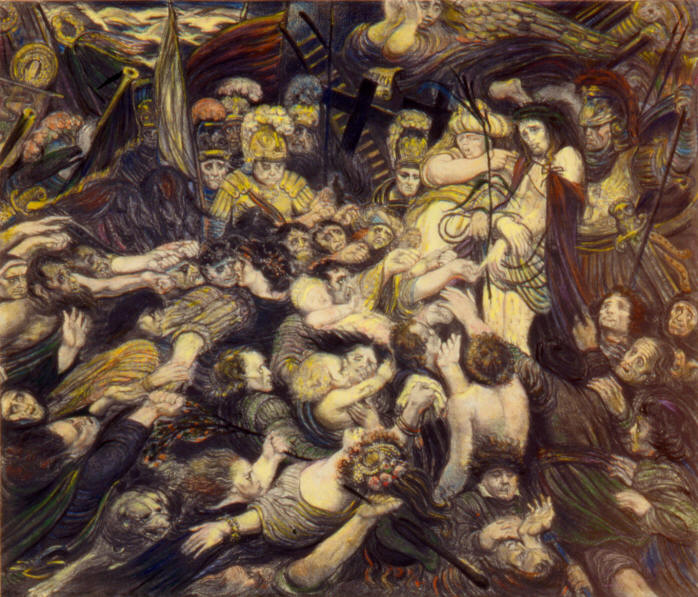
“Christ aux Outrages”
Henri de Groux – c. 1894-1898 – Lithograph with Pastel
This is the only artwork in our sermon series that is not from the
middle ages or renaissance. In this French lithograph from the late 1800’s
we see Christ in a crown of thorns, being tormented, surrounded by an angry mob.
It reminds me of Isaiah chapter 53: “He was despised and rejected by men, a man
of sorrows, and familiar with suffering. Like one from whom men hide their faces
he was despised, and we esteemed him not. Surely he took up our infirmities and
carried our sorrows. We observed him stricken by God, smitten by him, and
afflicted. He was pierced for our transgressions, he was crushed for our
iniquities; the punishment that brought us peace was upon him, and by his wounds
we are healed. We all, like sheep, have gone astray, each of us has turned
to his own way; and the Lord has laid on him the iniquity of us all. . .
He was led like a lamb to the slaughter.”
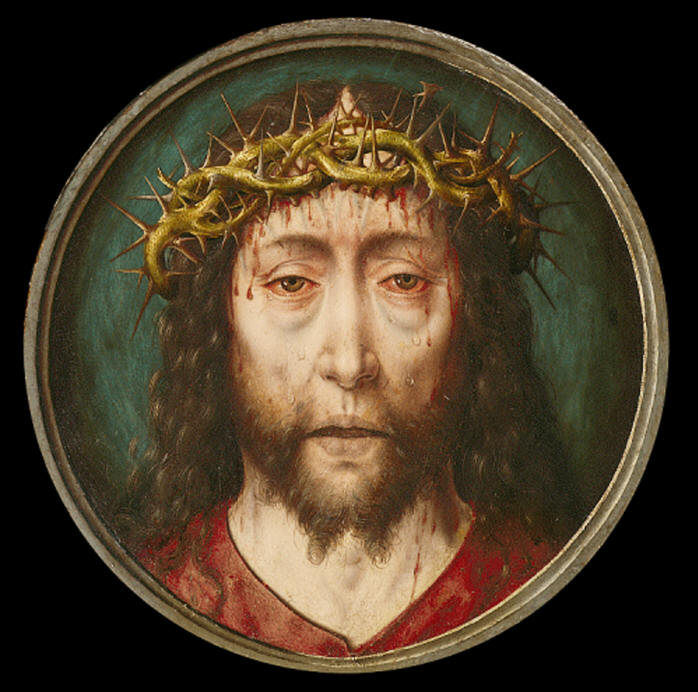
“Christ Crowned with Thorns”
Albrecht Bouts – 1493 – Oil on Panel
This haunting Belgian painting of Christ wearing the crown of thorns is
on display at the Nelson-Atkins Museum. It vividly, poignantly portrays
the excruciating sufferings our Lord endured in his trial, condemnation, and
flagellation.
What does Christ’s unjust condemnation in the judgment halls of men
mean for you? Scripture warns, “Man is destined once to die, and after
that to face the judgment . . . For we must all appear before the judgment
seat of Christ.” But the Good News is, Christ’s own unjust condemnation in
the judgment halls of men earned you freedom from condemnation before the
judgment seat of Christ. In the final judgment you will be declared not
guilty, because the Judge himself has already borne the punishment for you, by
his own suffering, by his own unjust condemnation, by his own death and
resurrection.
Using courtroom language in the book of Isaiah, the Lord announces the
beautiful decree of NOT guilty that will be pronounced upon you in the judgment
hall of God, on account of the unjust condemnation Christ endured in the
judgment halls of men: “Come now, and let us reason together, says the Lord.
Though your sins be as scarlet, they shall be as white as snow; though they be
red like crimson, they shall be as wool.”
“He was pierced for our transgressions, he was crushed for our
iniquities; the punishment that brought us peace was upon him.”
Return to Top | Return to Sermons | Home | Email Church Office